8 Takeaways on Shipping Expectations for Online Shopping Experiences
Published on Apr 14, 2021

A memorable online shopping experience that drives customer retention is one that is considered from end to end. You know your customers are savvy, and you've worked hard to build a website tailored to their expectations and needs. But the last step in the process—shipping costs and arrangements—can leave a poor lasting impression and jeopardize return business if it's an unpleasant surprise.
Do you know if you're meeting customer expectations for this crucial step of the online shopping experience? Are you giving away too much?
Online shopping—and shipping—on the rise
With last year’s accelerated surge in cross-channel and online shopping—which included 146% growth in all online retail orders over past years in the United States and Canada alone—companies were forced to take a critical eye to their digital transformation maturity and work quickly to evolve their strategies as customers shied away from brick and mortar stores.
The biggest threat to many online stores lies in trying to keep up with Amazon. With the pandemic-driven shift in focus from shoppers being in-store to an online shopping experience, retailers found themselves in even more competition with the e-commerce giant. But how could they compete with Amazon Prime’s two-day free shipping? Would customers be willing to wait longer for delivery? Or pay for shipping?
The good news is that with 41% of consumers reporting they shop online weekly and 79% shopping online at least once a month, online retailers have a big opportunity to win potential customers’ online business.
To get answers to these questions (and more) we turned to SMG’s location-based mobile research app and collected feedback from more than 18,000 consumers on what they expect from brands’ shipping and delivery policies. Here are the results on consumer behavior + attitudes from our research, along with tips for application:
Which shipping option to consumers prefer?
The "standard" level of shipping is also the customer’s standard. When surveyed about which shipping option they choose, 37% of consumers indicated they pick "standard" shipping, with the second-most popular option being the fastest free shipping option. Priority, next day, same day, and physical pick-up options account for only about a third of respondents when considered together.
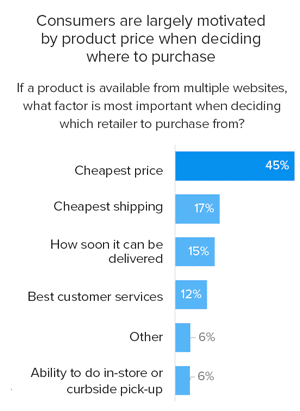
Takeaway: Many customers aren't driven by a myriad of shipping options for online orders as long as they see the standard or free shipping options as fair.
How fast should shipping be?
The problem of Amazon's Prime's two-day free shipping might loom large in the world of e-commerce sales, but it's not necessarily the expectation for all customers. For example, 54% of shoppers would be satisfied with 5-day standard shipping for online orders, and 67% would be satisfied with 4-day shipping.
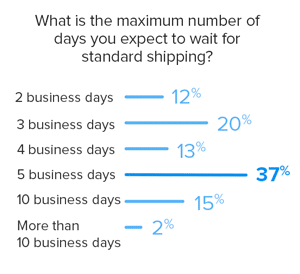
Takeaway : Customers don't need the fastest possible shipping to feel they've had a positive experience. A standard shipping window of 4 days would keep the majority of customers happy.
How much should shipping cost?
While our survey indicates e-commerce sales don't need to arrive at lightning speed, shipping costs need to be low. When it comes to standard-level shipping, 40% of shoppers expect website orders to ship for free. If they are paying to have orders shipped, 52% of customers expect to pay less than $7 per order for standard shipping. On the other hand, if they want expedited shipping, 52% of customers expect to have to pay more than $7.
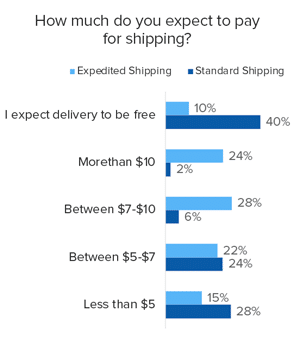
Takeaway: We’ll discuss the silver lining to this data, but the important thing here is that the online customer experience is seen more as a necessary service than a convenience. After all, in-store shopping is free, and customers expect a very similar user experience from an e-commerce website.
Should there be an order minimum?
While online shoppers expect shipping to be free or inexpensive, they don't expect to get it for nothing. Only 27% of consumers think there should be no order minimum for free standard delivery, but 61% think a minimum of at least a $25 order size is a fair gateway to free standard shipping.
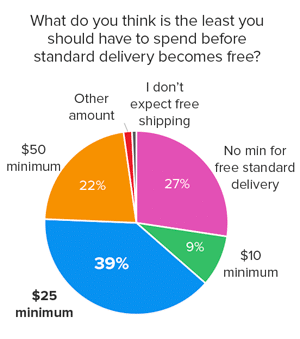
Takeaway: People seem to fundamentally realize a certain amount of business is necessary to rationalize free shipping from an online store, so brands would do well to establish reasonable minimums for online sales.
Why do online shoppers buy?
When it comes to comparative shopping, product price is far and away the #1 concern. If a product is available from multiple online sellers, 45% of e-commerce customers indicate item price is the deciding factor. Every other factor rated a distant second, with cheap shipping, delivery timeframe, and customer service each garnering less than 17%.

Takeaway: Small businesses may have an advantage here if they serve niche markets or deliver on superior product quality. For larger online retailers, the fact is comparison shopping is easier than ever, customer loyalty is relatively low, and price is the most important part of the equation for identical items. Including product descriptions could help customers differentiate between similar items.
When do customers want to know about shipping costs?
When it comes to telling online customers about shipping costs on a shopping site, earlier is better. Only 22% of consumers indicate they prefer to be told about shipping charges at checkout. In contrast, 74% of respondents would be satisfied knowing about the cost of shipping while browsing for products.
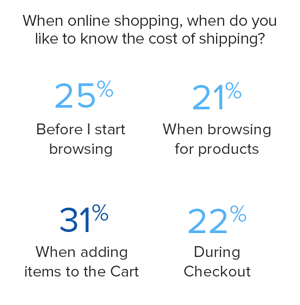
Takeaway: If brands want to create a great online shopping experience, it's a good idea to let customers know shipping costs as soon as possible.
How can customers feel good about online shopping?
As consumer behavior has moved from physical stores to online customer experiences in the past few years, concerns about the environment have migrated, as well. When asked, 62% of consumers in the United States said they "agree" or "strongly agree" they care about the impact their online purchases have on the environment. When asked which environmentally conscious actions would have the biggest impact on their online shopping decisions, 40% chose reduced packaging + 26% selected biodegradable packaging.
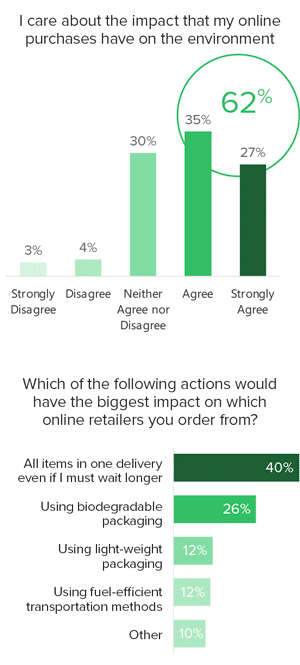
Takeaway: Customer concern about environmental problems is at least partially an emotional connection, so this can be a great place for brands to relate to customers on a personal level. The simple act of using reduced, biodegradable packaging and publicizing environmental efforts can go a long way.
Do customers need to ship items together?
While customers may want qualified free standard shipping in most cases, they're willing to wait a little bit for the sake of the environment. Only 26% of those surveyed indicated they'd prefer to receive separate shipments of multiple items from the same order to save delivery time.
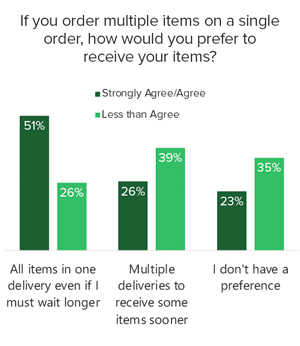
Takeaway: Retailers don't need to split orders and rush items out the door to provide the best shopping experience. This solution can be an intersection of a few previous strategies, potentially providing effective ways to reduce shipping expenses through consolidation and improving brand image by promoting environmentally conscious decisions.
Make shipping the finishing touch to your online shopping experience
After putting effort into developing an online shopping experience that delights your customers, be sure your final touchpoint is a good one. By applying these takeaways, you can help ensure that you not only balance shipping expenses with customer expectations, but also finish the interaction by making the experience one that helps the customer feel good about their environmental impact.
For more retail trends you should be monitoring and acting on this year to move your retail experiences in the right direction, read the report: 4 retail industry trends shaping the future of CX.
Related articles

Key Strategies to Create Personalized In-Store Experiences
Customers now expect personalized digital experiences that are aligned with visiting brick and mortar locations. Here is how to maintain consistency.

How experience design shapes brand experience
Discover how starting at the design phase can elevate brand experience by aligning early decisions with customer needs, market trends, and community feedback.

3 experience management tenets executives should adopt this year
While the curveball that was 2020 is behind us, many of us in the experience management (XM) space are still getting our arms around the magnitude of change in our programs as we rapidly adapted to me